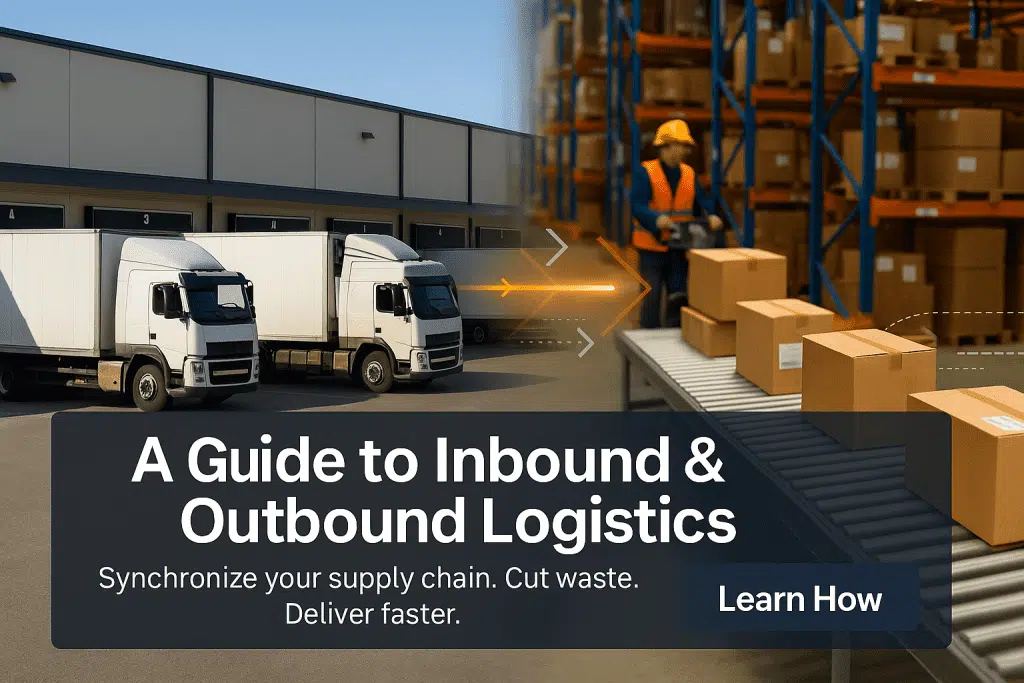Author: Jason Martin
Reviewed by: Ecommerce Operations Lead
Last updated: October 22, 2025
Executive TLDR
Inbound logistics makes inventory sellable fast with clean ASNs, booked docks, and a 1 to 3 day dock to stock target.
Outbound logistics ships orders right and on time with scan at pick and pack, a simple packaging matrix, and rate shopping.
Centralized inventory in the Midwest reaches most buyers in 1 to 3 days by ground while keeping costs low.
For consumables, capture lot and expiry at receiving and pick FEFO to stay compliant and fresh.
Track five numbers daily, receiving SLA, dock to stock time, order accuracy, on time ship rate, and billable vs actual weight.
Want both sides of your logistics working cleanly — Talk to an Expert
Table of contents
What inbound and outbound logistics really are
Inbound logistics, make stock sellable fast
Outbound logistics, ship right and on time
One inventory pool, many fast paths
Controls for dated and regulated products
The 30 day improvement plan
Why Product Fulfillment Solutions
FAQ
What inbound and outbound logistics really are
Inbound logistics brings goods into your network and gets them ready to sell. Outbound logistics moves customer orders out the door fast and accurate. When inbound is sloppy, the dock jams and inventory sits. When outbound is vague, orders miss the promise day and returns rise. The fix is simple. Standardize the inputs on the way in and make the packing rules obvious on the way out.
Inbound logistics, make stock sellable fast
Send complete ASNs
PO, SKUs, barcodes, quantities by carton and pallet, weights and dimensions.
Print carton and pallet labels that match the file so receiving scans, not guesses.
Book dock times and stage cleanly
Post a dock schedule and staff to it.
Create an exception lane for overages, shorts, and damages so putaway never stalls.
Target 1 to 3 day dock to stock
From truck arrival to available in the system within three days.
If space is tight or seasonal, expand cleanly with warehousing and storage solutions.
Putaway with locations that people can see
Large, high contrast bin IDs.
Slot fast movers near pack to cut walking.
Keep the same facts on every screen with real time information.
Outbound logistics, ship right and on time
Pick rules that hold under pressure
Batch single line orders for speed.
Cluster or wave pick multi line orders.
Always scan at pick to stop swaps on look alike SKUs.
Pack with a simple matrix
Post which mailer or carton to use by product family.
Add inserts only when they help, instructions, care, reorder path.
Print the shipping label after the final scan at pack.
Learn more under pick and pack services.
Rate shop every label
Blend national and regional carriers.
Choose the cheapest service that still hits the promise day.
Protect margin with discounted shipping rates.
One daily cut off
Publish a clear cut off.
Staff to clear the queue to zero by that time and keep the promise tight.
One inventory pool, many fast paths
Keep stock centralized at a Midwest hub to reach most buyers in 1 to 3 days by ground. Route by promise and cost.
Marketplaces and retail winners can feed through compliance paths like FBA or EDI when it makes sense.
DTC and the long tail ship from the 3PL hub with the same scan and packaging rules.
Explore 3PL fulfillment and ecommerce fulfillment services for single pool routing.
Controls for dated and regulated products
If you ship supplements, vitamins, cosmetics, or OTC:
Capture lot and expiry at receiving.
Enforce FEFO at pick so older product moves first.
Kitting sheets include component lots for bundles and subscriptions.
Quarantine questionable returns and document destruction.
For category depth, review health and wellness fulfillment services and kitting assembly services.
The 30 day improvement plan
Week 1, lock inbound
Finalize the ASN template and share sample labels.
Post the dock schedule and a receiving checklist.
Start reporting dock to stock daily.
Week 2, fix the floor
Print large bin IDs.
Slot fast movers near pack and separate look alike SKUs.
Stand up an exception lane for rebag or relabel.
Week 3, instrument outbound
Turn on scan at pick and a second scan at pack.
Post the packaging matrix at every bench.
Publish one daily cut off and staff to it.
Week 4, pilot and tune
Run a live pilot on top movers.
Track order accuracy, on time ship rate, handling time, and billable vs actual weight.
Fix outliers, then roll the playbook to the rest of the catalog.
Why Product Fulfillment Solutions
Central U.S. hub in Cincinnati for national 1 to 3 day ground coverage.
Barcode first receiving aligned to accurate ASNs for predictable dock to stock speed.
Pick and pack standards with right size packaging and second scan at pack.
Small parcel optimization that rate shops every label.
Retail and marketplace readiness with EDI solutions and connections and FBA prep services.
Real time status and shared views under real time information.
FAQ
What is the fastest way to improve inbound
Send complete ASNs with matching labels and book dock times. Report dock to stock daily and fix misses the same day.
How do we keep outbound accurate when volume spikes
Scan at pick and add a second scan at pack. Keep a small exception lane for rework so the main line never stalls.
Do I need multiple warehouses
Start centralized. A Cincinnati hub reaches most buyers quickly with ground. Add nodes only when the data proves lower cost and better service.
How do I cut parcel costs without slowing delivery
Right size packaging and rate shop every label. Blend national and regional carriers.
What accuracy should we target
99.7 percent or better. Separate look alike SKUs and keep bin labels large and visible.

